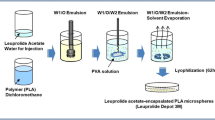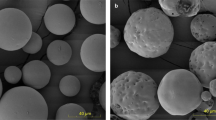Abstract
Purpose. The purpose of this study was to obtain an in vitro/in vivo correlation for the sustained release of a protein from poly(ethylene glycol) terephthalate (PEGT) / poly(butylene terephthalate) (PBT) microspheres.
Methods. Radiolabeled lysozyme was encapsulated in PEGT/PBT microspheres via a water-in-oil-in-water emulsion. Three microsphere formulations varying in copolymer composition were administered subcutaneously to rats. The blood plasma was analyzed for radioactivity content representing released lysozyme at various time points post-dose. The in vitro release was studied in phosphate-buffered saline.
Results. The encapsulation efficiency, calculated from the radioactivity in the outer water phase of the emulsion, varied from 60-87%. Depending on the PEG segment length and wt% PEGT, the lysozyme was released completely in vitro within 14 to 28 days without initial burst. 14C-methylated lysozyme could be detected in the plasma over the same time courses. The in vitro/in vivo correlation coefficients obtained from point-to-point analysis were greater than 0.96 for all microsphere formulations. In addition, less then 10% of administered radioactivity remained at dose site at 28 days for the microsphere formulations, indicating no notable retention of the protein at the injection site.
Conclusion. The in vitro release in phosphate-buffered saline and the in vivo release in rats showed an excellent congruence independent of the release rate of 14C-methylated lysozyme from PEGT/PBT microspheres.
Similar content being viewed by others
References
S. P. Schwendeman, H. R. Costantino, R. K. Gupta, and R. Langer. Peptide, protein, and vaccine delivery from implantable polymeric systems: progress and challenges. In K. Park (ed.), Controlled Drug Delivery, Challenges and Strategieys. American Chemical Society, Washington, DC, 1996 pp. 229-267.
P. Couvreur and F. Puisieux. Nano-and microparticles for the delivery of polypeptides and proteins. Adv. Drug Del. Rev. 10:141-162 (1993).
W. Lu and T. G. Park. Protein release from poly(lactic-co-glycolic acid) microspheres: protein stability problems. J. Pharm. Sci. Technol. 49:13-19 (1995).
G. Jiang, B. H. Woo, F. Kang, J. Singh, and P. P. DeLuca. Assessment of protein release kinetics, stability and protein polymer interaction of lysozyme encapsulated poly(D,L-lactide-co-glycolide) microspheres. J. Control. Rel. 79:137-145 (2002).
A. Aubert-Pouëssel, D. C. Bibby, M. C. Vernier-Julienne, F. Hindré, and J. P. Benoît. A novel in vitro delivery system for assessing the biological integrity of protein upon release from PLGA microspheres. Pharm. Res. 19:1046-1050 (2002).
T. Morita, Y. Sakamura, Y. Horikiri, T. Suzuki, and H. Yoshino. Evaluation of in vivo release characteristics of protein-loaded biodegradable microspheres in rats and severe combined immunodeficiency disease mice. J. Control. Rel. 73:213-221 (2001).
G. Jiang, W. Qiu, and P. P. DeLuca. Preparation and in vitro/in vivo evaluation of insulin-loaded poly(acryloyl-hydroxyethyl starch)-PLGA composite microspheres. Pharm. Res. 20:452-459 (2003).
P. Johansen, G. Corradin, H. P. Merkle, and B. Gander. Release of tetanus toxoid from adjuvants and PLGA microspheres: How experimental set-up and surface adsorption fool the pattern. J. Control. Rel. 56:209-217 (1998).
J. M. Bezemer, R. Radersma, D. W. Grijpma, P. J. Dijkstra, J. Feijen, and C. A. van Blitterswijk. Zero-order release of lysozyme from poly(ethylene glycol)/poly(buthylene terephthalate) matrices. J. Control. Rel. 64:179-192 (2000).
G. J. Beumer, C. A. van Blitterswijk, and M. Ponec. Biocompatibility of degradable matrix induced as a skin substitute: an in vivo evaluation. J. Biomed. Mater. Res. 28:545-552 (1994).
R. van Dijkhuizen-Radersma, S. C. Hesseling, P. E. Kaim, K. de Groot K, and J. M. Bezemer. Biocompatibility and degradation of poly(ether-ester) microspheres: in-vitro and in-vivo evaluation. Biomaterials 23:4719-4729 (2002).
J. M. Bezemer, R. Radersma, D. W. Grijpma, P. J. Dijkstra, and C. A. van Blitterswijk, J. Feijen. Microspheres for protein delivery prepared from amphiphilic multiblock copolymers. 2. Modulation of release rate. J. Control. Rel. 67:249-260 (2000).
M. van de Weert, R. van Dijkhuizen-Radersma, J. M. Bezemer, W. E. Hennink, and D. J. A Crommelin. Reversible aggregation of lysozyme in a biodegradable amphiphilic multiblock copolymer. Eur. J. Pharm. Biopharm. 54:89-93 (2002).
Y. Machida, H. Onishi, A. Kurita, H. Hata, A. Morikawa, and Y. Machida. Pharmacokinetics of prolonged-release of CPT-11-loaded microspheres in rats. J. Control. Rel. 66:159-175 (2000).
I. Soriano, C. Evora, and M. Llabrés. Preparation and evaluation of insulin-loaded poly(DL-lactide) microspheres using an experimental design. Int. J. Pharm. 142:135-142 (1996).
J. L. Cleland, O. L. Johnson, S. Putney, and A. J. S. Jones. Recombinant human growth hormone poly(lactic-co-glycolic acid) microsphere formulation development. Adv. Drug Del. Rev. 28:71-84 (1997).
T. K. Kim and D. J. Burgess. Pharmacokinetic characterization of 14C-vascular endothelial growth factor controlled release microspheres using a rat model. J. Pharm. Pharmacol. 54:897-905 (2002).
C. J. H. Porter, G. A. Edwards, and S. A. Charman. Lymphatic transport of proteins after s.c. injection: implications of animal model selection. Adv. Drug. Deliv. Rev. 50:157-171 (2001).
A. Supersaxo, W. R. Hein, and H. Steffen. Effect of molecular weight on the lymphatic absorption of water-soluble compounds following subcutaneous administration. Pharm. Res. 7:167-169 (1990).
C. M. Negrín, A. Delgado, M. Llabrés, and C. Évora. In vivo-in vitro study of biodegradable methadone delivery systems. Biomaterials 22:563-570 (2001).
M. Tracy, K. L. Ward, L. Firouzabadian, Y. Wang, N. Dong, R. Qian, and Y. Zhang. Factors affecting the degradation rate of poly(lactide-co-glycolide) microspheres in vivo and in-vitro. Biomaterials 20:1057-1062 (1999).
G. Spenlehauer, M. Vert, J. P. Benoit, and A. Boddaert. In vitro and in vivo degradation of poly(D,L lactide/glycolide) type microspheres made by solvent evaporation method. Biomaterials 10:557-563 (1989).
T. G. Park, W. Lu, and G. Crotts. Importance of in vitro experimental conditions on protein release kinetics, stability and polymer degradation in protein encapsulated poly(D,L-lactic acid-co-glycolic acid)microspheres. J. Control. Rel. 33:211-222 (1995).
R. V. Diaz, M. Llabrés, and C. Évora. One-month sustained release microspheres of 125I-bovine calcitonin: in vitro-in vivo studies. J. Control. Rel. 59:55-62 (1999).
A. J. Kuijpers, P. B. van Wachem, M. J. A. van Luyn, G. H. M. Engbers, J. Krijgsveld, S. A. J. Zaat, J. Dankert, and J. Feijen. In vivo and in vitro release of lysozyme from cross-linked gelatin hydrogels: a model system for the delivery of antibacterial proteins from prosthetic heart valves. J. Control. Rel. 67:323-336 (2000).
R. K. Gupta, A. C. Chang, P. Griffin, R. Rivera, and Y. Y. Guo. Determination of protein loading in biodegradable polymer microspheres containing tetanus toxoid. Vaccine 15:672-678 (1997).
J. Zuidema, F. Kadir, H. A. C. Titulaer, and C. Oussoren. Release and absorption rates of intramuscularly and subcutaneously injected pharmaceuticals (II). Int. J. Pharm. 105:189-207 (1994).
S. Y. Yen, K. C. Sung, J. J. Wang, and O. Y. P Hu. Controlled release of nalbuphine propionate from biodegradable microspheres: in vitro and in vivo studies. Int. J. Pharm. 220:91-99 (2001).
J. L. Cleland, A. Daugherty, and R. Mrsny. Emerging protein delivery methods. Curr. Opin. Biotechnol. 12:212-219 (2001).
K. Yamaguchi and J. M. Anderson. Biocompatibility studies of naltrexone sustained release formulations. J. Control. Rel. 19:299-314 (1992).
Author information
Authors and Affiliations
Corresponding author
Rights and permissions
About this article
Cite this article
van Dijkhuizen-Radersma, R., Wright, S.J., Taylor, L.M. et al. In Vitro/in Vivo Correlation for 14C-Methylated Lysozyme Release from Poly(Ether-Ester) Microspheres. Pharm Res 21, 484–491 (2004). https://doi.org/10.1023/B:PHAM.0000019303.12086.d1
Issue Date:
DOI: https://doi.org/10.1023/B:PHAM.0000019303.12086.d1




